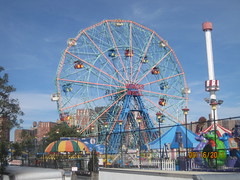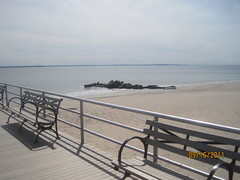Coney Island and the High Line are both places of amusement, culture, and society but they reflect these ideas in diverse ways. Over the past two weeks, I visited each of these sites and came to the unfortunate realization that even though I had lived here all my life, I had never taken the time to truly appreciate the arts of New York City. These visits opened my eyes and gave me the opportunity to take notice of the beauties of this ever growing and developing city.
“When you approach the High Line…what you first see is the kind of thing urban parks were created to get away from” (Goldberger). Urban parks are intended to allow their visitors to enjoy a delightful landscaped area and to unwind in its nature. However, as I stood on 10th Avenue and 14th street staring at the High Line from below, it seemed to do nothing of this sort. I knew that the High Line was a beautifully designed, 25-foot high park, but all I saw was an unwelcoming, heavy, steel structure. However, as I went up the stairs and laid my eyes on the remarkable nature for the first time, I now understood what the High Line was actually about. On that evening, I walked from 14th street to 30th street, taking in the colorful flowers that were visible due to bright lights placed along them, the stream of water, the benches that rose from the floor, the berries, the plants climbing up the fences, and the lights of the city both below and above me. With all the splendor of the High Line surrounding me, I couldn’t believe that people had once wished to demolish it. Thankfully, instead of paving over the High Line, it was incorporated into a place that removes you from the normal city atmosphere but at the same time is uniquely urban.
I was now able to fully understand what Goldberger had meant when he had written that, “Walking on the High Line is unlike any other experience in New York. You float about 25 feet above the ground, at once connected to street life and far away from it.” Although you’re able to see the street life, when you’re on the High Line you’re not apart of it anymore. New York City is known for its hustle-and-bustle, always moving quickly personality. However, the High Line is slower moving and serene. Couples are holding hands walking leisurely down the path and people are sitting on the benches reading books and relaxing amongst all this nature surrounding them. You no longer have to worry about being trampled over by a crowd of people walking towards you or getting lost in a never-ending metropolis. It’s as if you had entered a part of New York City that is ideal and unrealistic.
A piece of artwork that grabbed my attention was “Still Life with Landscape” by Sarah Sze. This steel structure acts as an observatory for birds, butterflies and insects by containing feeding spots and birdbaths. I found this compelling because similar to the High Line, this structure has a steel foundation that holds up a piece of nature. It amplifies the goal of the High Line to encourage people to take a break from the fast pace of the city and to instead, internalize the beauty surrounding them.
Whereas the High Line represented the serene side of recreation and culture, Coney Island on the other hand was more “out there.” With all of its amusement rides, lights, and attractions, it gave more of a “look at me” attitude that I hadn’t felt at the High Line. However, within itself, Coney Island has a contrast. On one hand, it’s a fast moving, exciting place where you could have a fun filled day with your family but on the other hand, it allows you to peacefully reflect on your life while gazing at the waves and seagulls flying by. I especially enjoyed the pier because it gave me an opportunity to get close to the ocean without having to go through the sand, which I am not particularly a fan of. As I walked on the Boardwalk, I noticed that many of the trashcans had been painted. They had drawings and names of random people on them; these paintings reminded me of the drawings I made as a child that my parents would hang up on the refrigerator. They made me feel more at home even though I was miles away.
In Delirious New York, Rem Koolhaas talks about electricity and how “the introduction of electricity makes it possible to create a second daytime” (35). Throughout my life, my favorite part about Coney Island has always been being able to see the rides lit up during the evenings. It gives Coney Island a whole new feeling and the contrast between the darkness and the lights fully isolates each ride from everything surrounding it. Although there is a lot of congestion, which Koolhaas discusses, the lights allow you to see each attraction individually. I found both of these sites very enjoyable and I’m looking forward to going again sometime.
Goldberger, Paul. “Miracle Above Manhattan.” National Geographic April 2011: 122-137. Print.
Koolhaas, Rem. Delirious New York. New York: Monacelli Press, 1994. Print.

 This steel structure acts as an observatory for birds, butterflies and insects by containing feeding spots and birdbaths. I found this compelling because similar to the High Line, this structure has a steel foundation that holds up a piece of nature. It amplifies the goal of the High Line to encourage people to take a break from the fast pace of the city and to instead, internalize the beauty surrounding them.
This steel structure acts as an observatory for birds, butterflies and insects by containing feeding spots and birdbaths. I found this compelling because similar to the High Line, this structure has a steel foundation that holds up a piece of nature. It amplifies the goal of the High Line to encourage people to take a break from the fast pace of the city and to instead, internalize the beauty surrounding them. Island on the other hand was more “out there.” With all of its amusement rides, lights, and attractions, it gave more of a “look at me” attitude that I hadn’t felt at the High Line. However, within itself, Coney Island has a contrast. On one hand, it’s a fast moving, exciting place where you could have a fun filled day with your family but on the other hand, it allows you to peacefully reflect on your life while gazing at the waves and seagulls flying by. I especially enjoyed the pier because it gave me an opportunity to get close to the ocean without having to go through the sand, which I am not particularly a fan of. As I walked on the Boardwalk, I noticed that many of the trashcans had been painted. They had drawings and names of random people on them; these paintings reminded me of the drawings I made as a child that my parents would hang up on the refrigerator. They made me feel more at home even though I was miles away.
Island on the other hand was more “out there.” With all of its amusement rides, lights, and attractions, it gave more of a “look at me” attitude that I hadn’t felt at the High Line. However, within itself, Coney Island has a contrast. On one hand, it’s a fast moving, exciting place where you could have a fun filled day with your family but on the other hand, it allows you to peacefully reflect on your life while gazing at the waves and seagulls flying by. I especially enjoyed the pier because it gave me an opportunity to get close to the ocean without having to go through the sand, which I am not particularly a fan of. As I walked on the Boardwalk, I noticed that many of the trashcans had been painted. They had drawings and names of random people on them; these paintings reminded me of the drawings I made as a child that my parents would hang up on the refrigerator. They made me feel more at home even though I was miles away.

